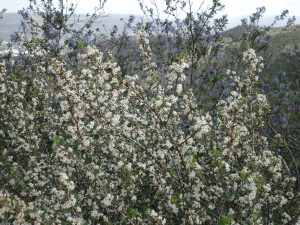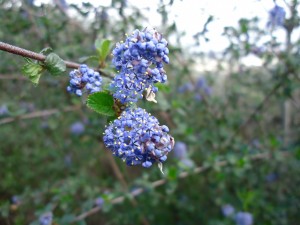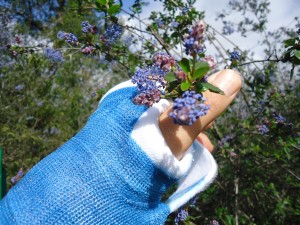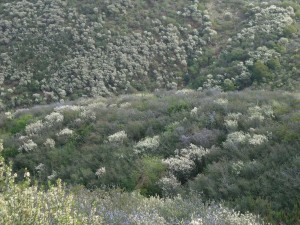SEE AND KNOW THIS: Now is the time to enjoy Ceanothus
I have noticed Ceanothus flowering spectacularly this season in San Diego on the hills east of Encinitas. Two different Ceanothus species dominate these local hillsides, one with blue flowers (Ceanothus tomentosus) and one with white flowers (Ceanothus verrucosus). In addition to being spectacularly lovely when covered with flowers both species are fragrant and attractive to bees. The flowers of Ceanothus tomentosus range in color from intense violet blue to a pale sky blue. The entire range of colors is quite attractive and seeing them in habitat never fails to give me a small thrill.
I first noticed the white Ceanothus verrucosus flowering this year in the San Elijo hills during one of my many unfortunate trips to the Kaiser medical facility in San Marcos. The abundance of white flowers was such that it looked as though the hillside was covered with snow.
Ceanothus are easy care, pest free garden subjects as well. There are more than 40 species of Ceanothus native to California from varied habitats and ranging in size from ground covers to small trees. One of my favorites is a hybrid called Ray Hartman that grows quickly to 10-15 feet and has medium blue flowers. Many nurseries now carry native plants including Cedros Gardens in Solana Beach which features a large display of natives grown locally by Moosa Creek Nursery. All Ceanothus appreciate full sun and well-drained soils. Most are drought tolerant once established but they do need regular watering to get started. Ceanothus garden subjects.
As much as I love Ceanothus in gardens I find visiting them in natural areas to be the most inspiring. If you go soon to seek them out I’m sure you’ll find it inspiring as well. There’s a great short hiking trail and look out on Double Peak in San Marcos. If you take San Elijo Rd., three miles east from Rancho Santa Fe Rd. you can turn left on Double Peak drive and follow it all away to the top of the hill which affords you spectacular 360 views. The trail winds across the north slope.





